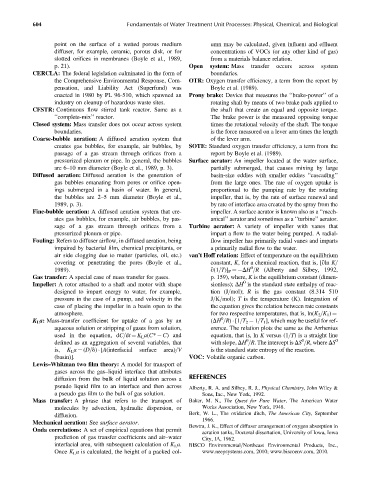Page 649 - Fundamentals of Water Treatment Unit Processes : Physical, Chemical, and Biological
P. 649
604 Fundamentals of Water Treatment Unit Processes: Physical, Chemical, and Biological
point on the surface of a wetted porous medium umn may be calculated, given influent and effluent
diffuser, for example, ceramic, porous disk, or for concentrations of VOCs (or any other kind of gas)
slotted orifices in membranes (Boyle et al., 1989, from a materials balance relation.
p. 21). Open system: Mass transfer occurs across system
CERCLA: The federal legislation culminated in the form of boundaries.
the Comprehensive Environmental Response, Com- OTR: Oxygen transfer efficiency, a term from the report by
pensation, and Liability Act (Superfund) was Boyle et al. (1989).
enacted in 1980 by PL 96-510, which spawned an Prony brake: Device that measures the ‘‘brake-power’’ of a
industry on cleanup of hazardous waste sites. rotating shaft by means of two brake pads applied to
CFSTR: Continuous flow stirred tank reactor. Same as a the shaft that create an equal and opposite torque.
‘‘complete-mix’’ reactor. The brake power is the measured opposing torque
Closed system: Mass transfer does not occur across system times the rotational velocity of the shaft. The torque
boundaries. is the force measured on a lever arm times the length
Coarse-bubble aeration: A diffused aeration system that of the lever arm.
creates gas bubbles, for example, air bubbles, by SOTE: Standard oxygen transfer efficiency, a term from the
passage of a gas stream through orifices from a report by Boyle et al. (1989).
pressurized plenum or pipe. In general, the bubbles Surface aerator: An impeller located at the water surface,
are 6–10 mm diameter (Boyle et al., 1989, p. 3). partially submerged, that causes mixing by large
Diffused aeration: Diffused aeration is the generation of basin-size eddies with smaller eddies ‘‘cascading’’
gas bubbles emanating from pores or orifice open- from the large ones. The rate of oxygen uptake is
ings submerged in a basin of water. In general, proportional to the pumping rate by the rotating
the bubbles are 2–5 mm diameter (Boyle et al., impeller, that is, by the rate of surface renewal and
1989, p. 3). by rate of interface area created by the spray from the
Fine-bubble aeration: A diffused aeration system that cre- impeller. A surface aerator is known also as a ‘‘mech-
ates gas bubbles, for example, air bubbles, by pas- anical’’ aerator and sometimes as a ‘‘turbine’’ aerator.
sage of a gas stream through orifices from a Turbine aerator: A variety of impeller with vanes that
pressurized plenum or pipe. impart a flow to the water being pumped. A radial-
Fouling: Refers to diffuser airflow, in diffused aeration, being flow impeller has primarily radial vanes and imparts
impaired by bacterial film, chemical precipitants, or a primarily radial flow to the water.
air side clogging due to matter (particles, oil, etc.) van’t Hoff relation: Effect of temperature on the equilibrium
covering or penetrating the pores (Boyle et al., constant, K, for a chemical reaction, that is, [qln K=
0
1989). q(1=T)] P ¼ DH =R (Alberty and Silbey, 1992,
Gas transfer: A special case of mass transfer for gases. p. 159), where, K is the equilibrium constant (dimen-
0
Impeller: A rotor attached to a shaft and motor with shape sionless); DH is the standard state enthalpy of reac-
designed to impart energy to water, for example, tion (J=mol); R is the gas constant (8.314 510
pressure in the case of a pump, and velocity in the J=K=mol); T is the temperature (K). Integration of
case of placing the impeller in a basin open to the the equation gives the relation between rate constants
atmosphere. for two respective temperatures, that is, ln(K 2 =K 1 ) ¼
0
K L a: Mass-transfer coefficient for uptake of a gas by an (DH =R) [1=T 2 1=T 1 ], which may be useful for ref-
aqueous solution or stripping of gases from solution, erence. The relation plots the same as the Arrhenius
used in the equation, dC=dt ¼ K L a(C* C) and equation, that is, ln K versus (1=T) is a straight line
0
0
defined as an aggregation of several variables, that with slope, DH =R. The intercept is DS =R, where DS 0
is, K L a ¼ (D=d) [A(interfacial surface area)=V is the standard state entropy of the reaction.
(basin)]. VOC: Volatile organic carbon.
Lewis–Whitman two film theory: A model for transport of
gases across the gas–liquid interface that attributes
diffusion from the bulk of liquid solution across a REFERENCES
pseudo liquid film to an interface and then across Alberty, R. A. and Silbey, R. J., Physical Chemistry, John Wiley &
a pseudo gas film to the bulk of gas solution. Sons, Inc., New York, 1992.
Mass transfer: A phrase that refers to the transport of Baker, M. N., The Quest for Pure Water, The American Water
molecules by advection, hydraulic dispersion, or Works Association, New York, 1948.
diffusion. Berk, W. L., The oxidation ditch, The American City, September
1966.
Mechanical aeration: See surface aerator.
Bewtra, J. K., Effect of diffuser arrangement of oxygen absorption in
Onda correlations: A set of empirical equations that permit
aeration tanks, Doctoral dissertation, University of Iowa, Iowa
prediction of gas transfer coefficients and air–water City, IA, 1962.
interfacial area, with subsequent calculation of K L a. BISCO Environmental=Northeast Environmental Products, Inc.,
Once K L a is calculated, the height of a packed col- www.neepsystems.com, 2010; www.biscoenv.com, 2010.

